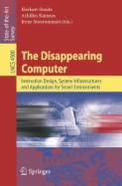The Disappearing Computer
“The most profound technologies are those that disappear. They weave themselves into the fabric of everyday life until they are indistinguishable from it.”
This statement in Mark Weiser’s well-known “The Computer for the Twenty-First Century” (Scientific American, 1991, pp. 66–75) has been a source of inspiration for many and still is an important
guideline for the work in the Smart Future Initiative.
The goal of making the computer disappear can happen in different ways. Disappearance can take different forms as described by Streitz (2001):
- physical disappearance refers to the miniaturization of devices and their integration in other everyday artefacts as, e.g., in clothes, so that you don’t see them anymore.
- mental disappearance refers to the situation that the artefacts can still be large but they are not perceived as computers because people discern them as, e.g., interactive walls or interactive tables. Thus, technology moves mentally into the background.
This raises some core questions: How can we design human-information interaction and support human-human communication and cooperation by exploiting the affordances of
existing artefacts in our environment? And, in doing so, how can we exploit the potential of computer-based support augmenting these activities?
“It seems like a paradox but it will soon become reality: The rate at which computers disappear will be matched by the rate at which information technology will increasingly permeate our
environment and determine our lives”. This statement by Streitz & Nixon (2005) in their special issue of 'Communications of the ACM' illustrates how computers are increasingly becoming an
important part of our day-today activities and will determine a wide range of the physical and social contexts of our future life.
More details on this can be found in various publications of Norbert Streitz
Furthermore, this approach was also the starting point and rationale for the EU-funded proactive initiative "The Disappearing Computer (DC)", a cluster
of 17 projects addressing a wide range of themes and issues and therefore being conducted by interdisciplinary research groups. A comprehensive overview over the projects is provided in the book by
Streitz et al. (2007). The Steering Group
of the DC-Network was chaired by Norbert Streitz.
One of the 17 DC-projects was "Ambient Agoras" coordinated by
Norbert Streitz
(at that time Fraunhofer IPSI, Germany).
References
Norbert Streitz (2019). Beyond 'Smart-Only' Cities: Redefining the 'Smart-Everything' Paradigm. Journal of Ambient Intelligence and Humanized
Computing. vol. 10, no. 2, pp. 791-812. (Springer). First online: 31. May 2018.
DOI: 10.1007/s12652-018-0824-1
Streitz, N. A. (2001). Augmented Reality and the Disappearing Computer. In: Smith, M., Salvendy, G., Harris, D., Koubek, R. (Eds.), Cognitive Engineering,
Intelligent Agents and Virtual Reality. Lawrence Erlbaum, 2001. pp. 738-742.
Streitz, N.A. & Nixon, P. (2005). The Disappearing Computer. Guest Editors' Introduction to Special Issue. Communications of the ACM, Vol. 48, March 2005. pp. 33-35.
Streitz, N. A., Kameas, I. Mavrommati (Eds.) (2007), The Disappearing Computer:
Interaction Design, System Infrastructures and Applications for Smart Environments. State-of-the-Art Survey, Springer LNCS 4500.




